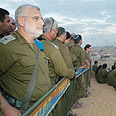
IDF officials warn of Gaza threat
Two years after disengagement, senior officers say decision-makers ignored their warnings prior to pullout, estimate Hamas building army in order to attack Israel. Expert: Confrontation may spill to West Bank
"The easiest thing is to say that the military intelligence did not issue a warning and failed to predict the developments," former IDF intelligence chief Brig.-Gen. Aharon Ze'evi Farkash said recently. "When we prepared for the disengagement, we mentioned all the scenarios for what might happen in the Strip, including the possibility of a 'Hamastan'."
According to Farkash, it was the decision-makers who chose to take the risk and carry on with the pullout, despite intelligence warnings.
Like Farkash, many senior IDF officers are concerned about the developments in the Strip, to which one official recently referred as "a security pressure cooker." He claimed that a clash between the Palestinians and Israel was inevitable and estimated that Katyusha attacks from Gaza are just a matter of time.
Main weakness: Philadelphi Route
Data gathered by the IDF on Gaza indicates that there is much room for concern. "Our main problem," said a military source, "is that on the outside, Gaza appears to be very quiet. It’s true that there are rocket barrages… but paradoxically they are at the bottom of our list of threats."According to defense officials, Hamas is rapidly building up its force in the Strip. The organization already has an army of 13,000 troops that undergo professional training. Furthermore, the group is amassing weapons obtained through smuggling.
Hamas is preparing for a confrontation with Israel, one officer explained, adding that the disengagement boosted the terror groups' morale and capabilities.
Israel's main weakness with regards to the Strip, said another senior officer, is the Philadelphi Route, from which the IDF withdrew after the pullout and which is used for arms smuggling and passage of Hamas activists. "Israel has hardly any ability to control what goes on there. It all depends on the international force, which is obviously not very highly-motivated."
General rehearsal in Lebanon
IDF data shows that since the disengagement, and up to mid-July, 584 terrorists were killed in the Gaza Strip, and about another thousand injured. Another 54 Gazan civilians were killed in various battles.Twelve Israeli’s were killed, half of which were civilian. “These numbers tell the whole story,” one officer said. “We left the Strip on an optimistic note, we made it clear to the other side that we would no longer stand for hostile actions against Israel, and that we would severely retaliate.
“But the numbers show that the blood baths are continuing. Hundreds of dead Palestinians prove how much tension there was there, and along with what’s happening there today, it’s hard to be optimistic.”
Brigadier-general (res) Shlomo Brom, formerly a senior official in the strategic branch of the Planning Directorate, and now a researcher at the Institute for National Security Studies, believes that the political and security scenarios in the Gaza Strip could have been predicted before Israel withdrew from it.
“By nature of the unilateral approach taken, there was no reason to assume that such a withdrawal would bring calm.” Brom emphasized the potential for escalation between the Strip and the West Bank. “We arrest a suspect in Nablus, and the response comes from Gaza in the form of Qassams; we respond, and we’ve created an escalation.”
Speaking of the West Bank, Brom said, “There are still active terror cells there, that have decided to lay low for the meantime, but could definitely become violent should the situation in Gaza change.”
Almost every security source has drawn a parallel between the current situation in Gaza and the events which occurred during the six years that led up to the Second Lebanon War.
Other sources warned against waiting too long before dealing with the situation in Gaza. “The only difference is that the IDF is prepared for a wide scale operation in Gaza,” one source explained. “The ball is now in the political echelon’s court.”










